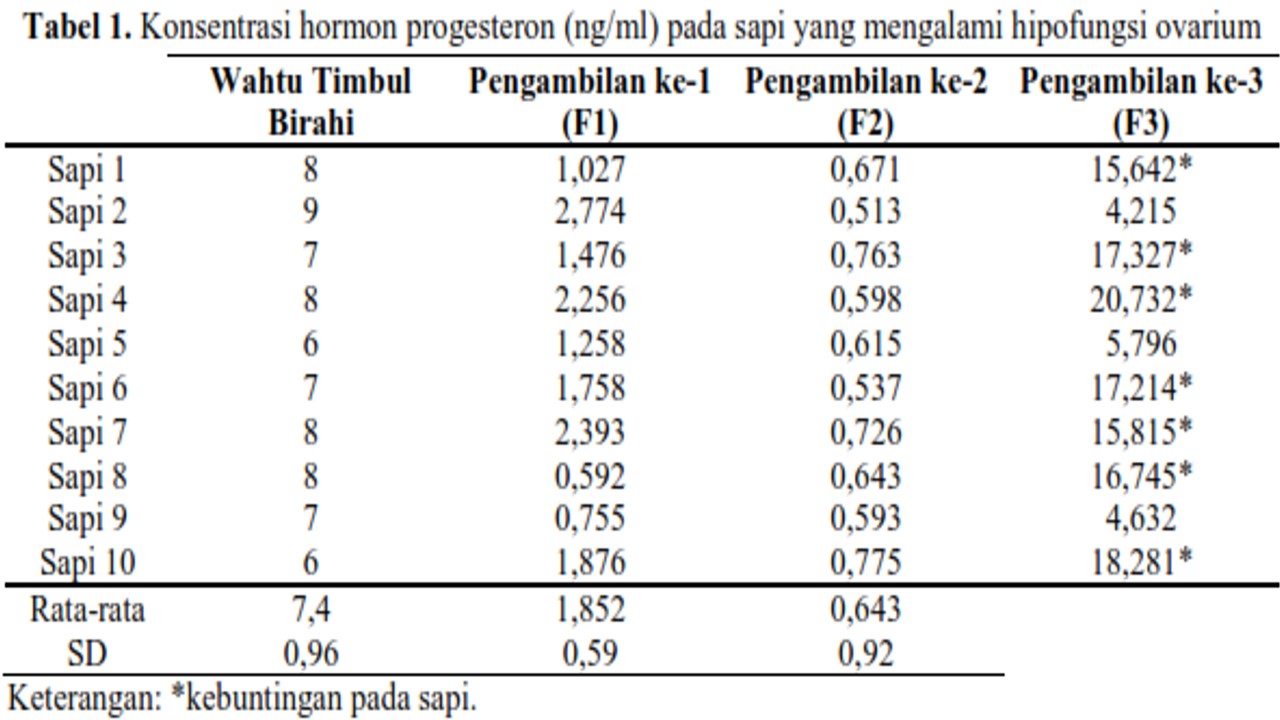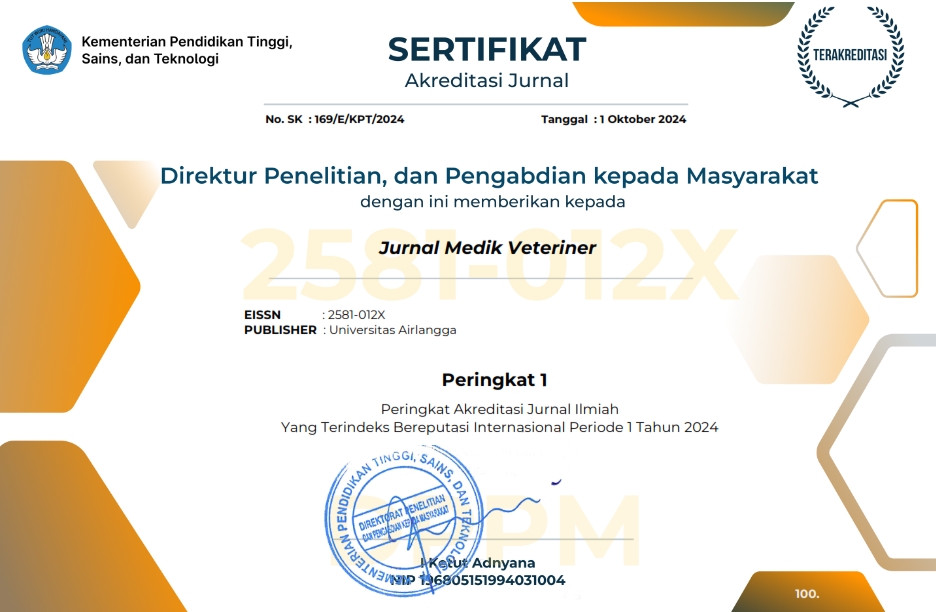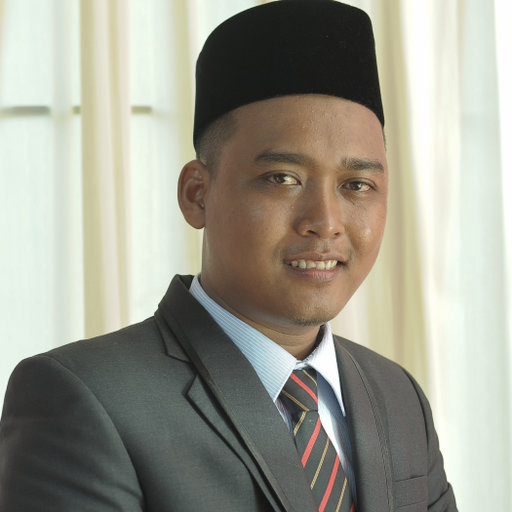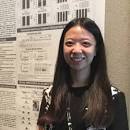Profile of Progesterone Levels After Administration of Gonadotropins in Dairy Cattle with Ovarian Hypofunction

Downloads
This study aimed to evaluate the profile of progesterone in dairy cattle with ovarian hypofunction. A total of 10 cows in this study were evaluated three times in the collection phase, i.e. (F1) when the cow was diagnosed with ovarian hypofunction, (F2) when the cow was in heat and (F3) 21 days after artificial insemination to detect pregnancy. Samples in the form of blood serum were then analyzed using ELISA. As a result, the average time of heat in ovarian hypofunction cows was 7,4 days. Progesterone levels in F1 were 1,027 ng/ml, 2,774 ng/ml, 1,476 ng/ml, 2,256 ng/ml, 1,258 ng/ml, 1,758 ng/ml, 2,393 ng/ml, 0,592 ng/ml, 0,755 ng /ml, 1,876 ng/ml, respectively. Progesterone levels in F2 were 0,671 ng/ml, 0,517 ng/ml, 0,763 ng/ml, 0,598 ng/ml, 0,615 ng/ml, 0,537 ng/ml, 0,726 ng/ml, 0,643 ng/ml, 0,593 ng/ml, 0,975ng/ml, respectively. Progesterone levels in F3 were 15,642 ng/ml, 4,215 ng/ml, 17,327 ng/ml, 20,721 ng/ml, 5,796 ng/ml, 17,214 ng/ml, 15,815 ng/ml, 16,745 ng/ml, 4,632 ng /ml, 18,281 ng/ml, respectively. The pregnancy rate in hypofunctional cows treated with PG-600 in this study was 70%.
Celik, O., Aydin, S., & Yilmaz, M. (2015). Basic Determinants of Reproductive function. Peptide, 72, 34-43.
Gernand, B., Rebbein, K., & Borstel, K. (2012). Incidences of and genetic parameters for mastitis, claw disorder, and common health traits recordered in dairy cattle contract herd. Journal Dairy Science, 95, 2144-2156.
Gobikrushanth, D., Bruinje, C., & Butler, A. (2017). Repeatability of antral folicle counts and anti-mullerian hormone and their associations determined at an unknown stage of follicular growth and an expected day of follicular wave emergence in dairy cows. Theriogenology, 18(1), 90-94.
Heise, L., Liu, Y., Stock, S., Rensing, F., & Simianer, A. (2016). The genetic structur of longevity in dairy cows. Journal Dairy Science, 99, 1253-1265.
Heringstad, A., Egger-Danner, D., Charfeddine, P., Stock, K., Sogstad, H., Fiedler, N., Thomas, G., Jong, M., & Miglior, A. (2018). Invited review: Genetics and claw health; opportunities to enhance claw health by genetic and claw health; Opportunities to enhance claw health by genetic selection. Journal Dairy Science, 101, 4801-4821.
Lestari, C. M. S., Purbowati, E., Dartosukarno, S., & Rianto, E. (2014). Sistem Produksi dan Produktivitas Sapi Jawa-Brebes dengan Pemeliharaan Tradisional. (Studi kasus di Kelompok Tani Ternak Cikoneng Sejahtera dan Lembu di Kecamatan Bandarharjo Kabupaten Brebes). Jurnal Peternakan Indonesia, 16(1), 8-14.
Pemayun, T. G. O. (2010). Kadar Progesteron akibat pemberian PMSG dan GN-RH pada Sapi Perah Yang Mengalami Anestru Postpartum. Buletin Veteriner Udayana, 2(2), 85-91.
Scandolo, D., Bilbao, P., Zapata, R., Melendez, A., & Bartolome, A. (2020). Efficacy of estradiol or GnRH in combination with progesteone intravaginal device to control the follicular wave dynamic. Journal Anireori Science, 10(6), 646.
Sina, M., Dirandeh, F., Deldar, A., & Shohreh, B. (2018). Inflammatory status and its relationship with different patterns of postpartum luteal activity and reproductive performance in early lactating Holstein cow. Theriogenology, 108, 262-6.
Siregar, T. N., Wajdi, F., Akmal, M., Fahrimal, Y., Adam, M., Panjaitan, B., Sutriana, A., Daud, R., Armansyah, T., & Meutia, N. (2017). Embryonic death incident due to heat stress and effect of therapy with gonadothropin releasing hormone (GnRH) in Aceh cattle. Veterinary Medicine Zootica, 75(97), 70-74.
Sutiyono, Daud, S., & Alam, S. (2017). Identifikasi Gangguan Reproduksi Sapi Betina di Peternakan Rakyat. Jurnal Veteriner, 18(4), 580-588.
Wathes, D. D., Pollot, J., & Richardson, C. (2014). Heifer fertility and Carry over consequence for life time production in dairy and beef cattle. Animal, 8, 91-104.
Copyright (c) 2023 Erprinanda Galuh Berliana, Suzanita Utama, Wurlina, Pudji Srianto, Tita Damayanti Lestari, Hermin Ratnani

This work is licensed under a Creative Commons Attribution-NonCommercial-ShareAlike 4.0 International License.
Authors who publish in this journal agree to the following terms:
1. The journal allows the author to hold the copyright of the article without restrictions;
2. The journal allows the author(s) to retain publishing rights without restrictions;
3. The legal formal aspect of journal publication accessibility refers to Creative Commons Attribution-NonCommercial-ShareAlike 4.0 International License (CC BY-NC-SA).






11.jpg)




















